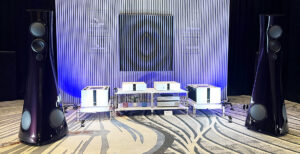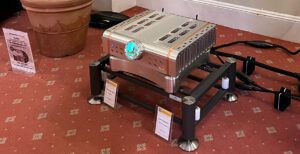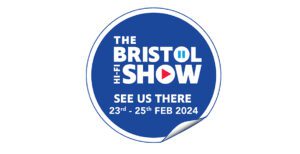
To audiophile manufacturers touring the high-end show circuit, CES marks the end of the year, rather than the beginning. It also is the start of a brief lull in event activity that kicks off again in May, beginning with the Munich High End show. And it’s in this interbellum period that you begin to ask why you often see the same brands demonstrated together all over the world.
These partnerships and allegiances can be surprisingly long-standing, There are companies that have been demonstrated together for more than 20 years. That’s not a working relationship… that’s a full-on bromance.
These bromances between companies exist for any number of reasons. Logically, if a company provides a soup-to-nuts solution across a few brands, it would be crazy not to exploit this (for example, why would the Fine Sounds group demonstrate Audio Research or Wadia electronics with anything other than loudspeakers from fellow Fine Sounds stable-mates Sonus faber?). There are also partnerships based on lines of distribution (if, say, Wilson Audio and Transparent Audio share almost all the same distributors the world over, then it makes sense to buddy up in demonstrations), mutual – and non-conflicting – respect for another’s work (VTL frequently demonstrates with a Spiral Groove turntable and a dCS digital front end for that reason). And sometimes it’s down to just plain liking the product (it’s perhaps why John DeVore keeps coming back to playing a Well-Tempered turntable in DeVore Fidelity demonstrations).
I’ve deliberately highlighted these companies as examples of doing it right. Take VTL for example. Over the years, VTL has worked with a number of diferent loudspeaker brands (including TAD, Rockport, Avalon and recently WIlson) to great effect, consistently making an outstanding presentation. The kind of thing that is a win for all; VTL shows just how flexible the products are sonically (because they work with such a wide variety of loudspeakers), the loudspeaker companies get to display their products in the ideal environment for a show and the customer gets to hear something more than just the locked groove of a similar system time and time again. These aren’t just thrown together; but a sophisticated mix of good products selected to produce a good sound. That takes time and effort on the part of the manufacturers involved, of course, and that’s worth applauding, and perhaps why VTLs demonstrations are often in ‘best in show’ lists from reviewers and general public alike.
These are the right ways to form an association, because the net result is a presentation that is directed toward creating a sound quality the manufacturers concerned feel reflects the products they produce. The fact it doesn’t always turn out that way in reality comes down to the randomness of shows. This isn’t an apology for poor sound at shows – a poor sound at a show is both unforgivable and life-threatening for the brands involved – but often the cards fall badly in some rooms. They just do… hundreds of people playing off the same power, not having enough pre-show time to let the system bed in and the fact most listeners have their hearing mechanism worn flat after the first five or six rooms at best does not bode well for the listening sessions.
There also are occasional and unexpectedly brilliant combinations (often from the more creative dealers and distributors who aren’t afraid to mix things up) and there are distinct trends and directions you might not wish to follow, but are internally consistent (Austin HiFi’s Resolution/Crimson/Toccaro-based systems don’t follow the audiophile herd, and sound radically different to most hi-fi as a result, but they do so with such intent and consistency, they ultimately invite difficult questions about what’s important in audio). Park those systems for now. I’m talking about the companies that should be making a good sound and yet never do. The components – taken individually – work well, but mixed together in a show situation, the combination of components simply never work together. And they show up together year, upon year, upon year.
Sometimes, this all seems a little too Game of Thrones, with companies seemingly forming allegiances for their mutual benefit, rather than to make a better-matched system. Often, in the manner of political partnerships taken out of the Shakespearean playbook, such things are formed by an eminence gris; not the designers or manufacturers harnessing the mutual aims of a fellow traveler, but often someone further down the food chain thinking the two brands work well together, sometimes with disastrous consequences.
Here’s a plan. Audio companies can be myopic at times. We forget that there are other folk out there, and begin to work to our own frame of reference. We set up systems that we think sound good and don’t spend time listening to rival systems at shows to see if any of them sound better (or worse). Interestingly, those who are generally considered to make a consistently good sound often have staff members walk the halls listening to their rivals. So, unless you really are dancing to the beat of a different drummer, go walkabout… and be honest with yourself.
I don’t take too much stock in lone-gunman dislikes voiced on forums. Part of the reason I’m not naming and shaming the weakest links here is for that very reason. But once again it comes down to consistency; if one person takes a dislike to a sound at one show, it can be put down to the luck of the draw, but if the sound is repeatedly disliked across a number of shows by a lot of people, it’s time for a rethink. There’s a tendency to dismiss such negativity with a pithy “Haters Gonna Hate” – and there’s a kernel of truth in that – but also maybe it’s time to re-think those political connections you’ve made, and whether they ultimately sound good. Sometimes, even the best bromances need a cooling off period.
Finally, it’s also worth remembering that the tightest bromances are often the ones that end badly. The ‘BFF’ partnership between Linn Products and Naim Audio in the 1980s was almost the stuff of legend in the UK. They were the Butch and Sundance, the Kirk and Spock and sometimes the Morcambe and WIse of audio… until the relationship went sour.
Tags: FEATURED
By Alan Sircom
More articles from this authorRead Next From Blog
See all
AXPONA 2024 Show Report Part One
- Apr 19, 2024

Audio Show Deluxe 2024: A photo show report
- Mar 28, 2024

Paul Messenger 1949-2024: A personal tribute
- Mar 26, 2024

Bristol Hi-Fi Show 2024: See You There!
- Feb 21, 2024










